The preset performance in Lightroom is probably the most elementary characteristic of this system round which photographers design their digital workflows. In whole, Lightroom makes use of 9 various kinds of presets that handle totally different areas of digital asset administration (DAM). The presets can be utilized in several modules of this system such because the
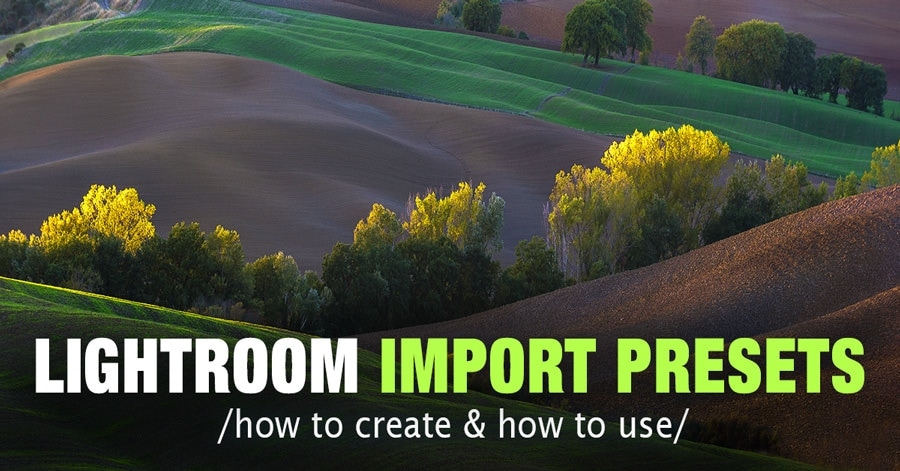
In one among my earlier tutorials, I dug deep and specified how every of the 9 varieties of Lightroom presets matches into the massive image of digital asset administration and picture modifying.
In at the moment’s tutorial, I’ll handle methods to create and use the Import Presets to simplify and pace up the method of importing new photographs into Lightroom.
Import Module
My private opinion is that the Import Module is probably the most complicated and even perhaps probably the most pointless a part of Lightroom.
Let me clarify.
Whenever you open Lightroom, you can not merely navigate to a folder in your pc, choose a picture, and begin modifying it as you’d in just about each different RAW editor. Earlier than you can begin modifying photographs, you should first import them into the Lightroom Catalog. When you choose the Import Photographs possibility, you’re introduced with a complicated interface that includes a gazillion totally different choices (or so it appears).
This at all times causes confusion for photographers who’re simply beginning to study this system. It is usually the most important stumbling block for Lightroom adoption.
That is the place the Import Presets can play an necessary function in overcoming the confusion of the Import Module. You make investments the time to grasp what import choices are important in your specific workflow after which save them as preset(s). From that second, you should utilize the import course of on autopilot.
Let me present you what import settings I take advantage of in my pictures, why I take advantage of them, and methods to save them as an Import Preset.
Creating Lightroom Import Presets
First, activate the Lightroom Import Module by going to the highest most important menu and deciding on
File > Import Photographs and Video…
Optionally, you should utilize the keyboard shortcut Ctrl (Possibility on Mac) + Shift + I.
As soon as the Import Module is energetic, you will see that the Supply Panel on the left facet. That is the place you choose the placement of the photographs that you simply intend to import into Lightroom. You can’t save the supply location as a preset as a result of the placement can differ from import to import relying on whether or not you import photographs from a reminiscence card, an exterior laborious drive, or a neighborhood folder.
File Format and Import Choices
The primary possibility it’s important to specify is the way you need Lightroom to deal with photographs through the import course of.

Do you wish to carry the pictures within the unique proprietary RAW format, or do you wish to convert them to an open supply digital unfavourable format (DNG)?
In my case, I don’t hassle with the conversion and hold all my RAW pictures within the unique format. I don’t see too many benefits for the additional step.
See additionally: Tips on how to Set up Lightroom Presets
Subsequent, you should specify if you wish to Copy, Transfer, or Add the pictures to Lightroom.
The Copy possibility implies that all the chosen photographs might be copied to the specified vacation spot in your pc with the originals intact on a reminiscence card.
The Transfer possibility implies that the unique photographs might be deleted from the reminiscence card throughout import.
I by no means use the Transfer possibility to make sure that I’ve a backup of the unique information within the occasion of file corruption through the switch.
The Add possibility is used when you have already got pictures in your pc in the suitable location and also you merely wish to add them to the catalog.
For instance, for those who manually copied information from a reminiscence card to a pc, you’d merely use the Add possibility.
Subsequent, we transfer to the suitable panel the place many of the import choices are positioned.
File Dealing with
These are the choices I take advantage of within the File Dealing with panel in 99% of circumstances.

For quicker efficiency, I wish to guarantee that full measurement (1:1) previews are generated. I additionally choose the “Construct Good Previews” possibility. If you’re unsure what Good Previews are, check out my in-depth article right here: Lightroom Good Previews – When, Why and Tips on how to Use Them
I choose the “Don’t Import Suspected Duplicates” possibility to make sure that I don’t import the identical picture a number of occasions.
You’ve the choice of Making a Second Copy of the imported photographs on one other location like an exterior backup laborious drive. I don’t use this selection as a result of I’ve an automatic backup system that backs up my desktop pc each night time.
The “Add to Assortment” checkbox makes the imported photographs a part of the gathering of your alternative. I don’t use this perform.
To generate full-size previews and Good Previews for each imported picture takes a variety of processing energy and is time-consuming. After I import 5,000 RAW photographs after one among my journeys, this might take hours. I developed a routine to at all times begin the import course of earlier than I’m going to mattress at night time. After I get up within the morning, the import course of is full, and I’m prepared to begin processing my new photographs.
If I’m on the street with my laptop computer and can’t afford to empty the laptop computer battery to generate full-size previews, I take advantage of the minimalistic possibility—Embedded & Sidecar. On this case, Lightroom makes use of smaller previews which can be generated by the digital camera and embedded into the RAW information. This enables me to begin analyzing and culling my photographs in seconds with out taxing my laptop computer battery.
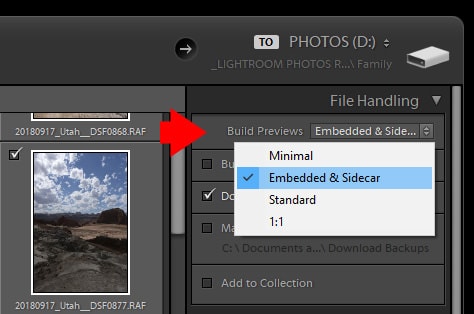
File Renaming
Lightroom provides you the choice to rename all of the information that you simply import into the catalog. That is an non-compulsory characteristic. It’s completely regular to maintain the unique file names generated by the digital camera.
I favor to rename my pictures by including the date the picture was taken and the placement to the unique file title. To verify my naming conference is constant, I take advantage of the File Renaming Presets.
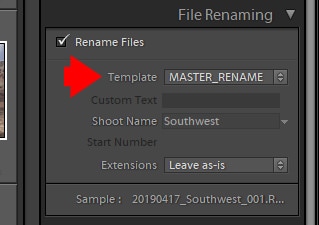
To discover ways to create and use File Renaming Presets, take a look at my devoted article right here: Tips on how to Create and Use Lightroom File Renaming Presets
Apply Throughout Import
Right here you’ll be able to apply the Develop Preset of your option to all of the imported photographs. For a very long time, I hardly used this performance. I solely lately began to understand it because of the advances in machine studying.
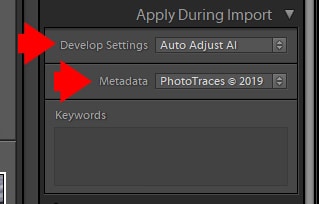
Within the Fundamental Panel of the Develop Module, there may be an Auto Button that’s powered by AI and machine studying algorithms. When the Auto perform is activated, Lightroom analyzes the picture and tries to enhance it robotically by making use of varied edits. This characteristic turns into simpler and helpful with each Lightroom replace. I created a Develop Preset (Auto Regulate AI) that solely does one factor—triggers the Auto perform. After I apply this preset to all my imported photographs, it provides me a extra sensible model to begin organizing and culling my newly imported photographs within the Library Module.
Subsequent, there’s a very helpful possibility to use a Copyright Preset to all of your photographs through the import course of. I take advantage of this selection with any picture I carry into Lightroom.
You may discover ways to create your personal Copyright Presets right here: Tips on how to Create and Use Lightroom Copyright Presets
You may depart the Key phrases part empty. Key phrase choice varies for each import so you’ll enter these manually.
Vacation spot
You specify the place you need the brand new photographs to be saved within the Vacation spot Panel.
That is the setup I take advantage of for the Vacation spot Panel.
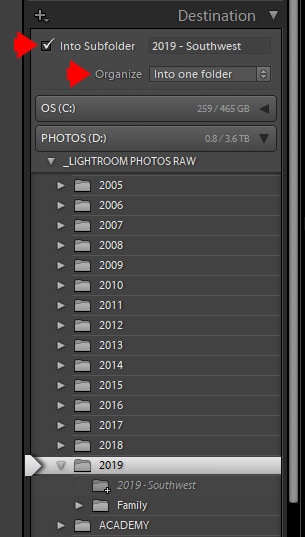
I specify the title of the folder I wish to create and retailer all of the imported photographs there. Optionally, you’ll be able to arrange the photographs By Date. For every date, Lightroom will create a devoted folder utilizing the date because the folder title.
Saving the Import Setting as a Presets
If you end up pleased with the Import settings, click on the black panel on the backside of the Import Module and the “Save the Present Settings as a New Preset…” possibility might be obtainable.
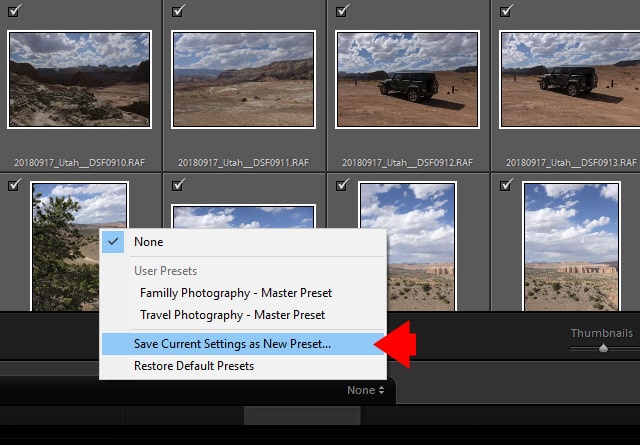
Title the brand new preset and click on the Save button.
You’re carried out.
Making use of the Import Presets
The subsequent time you import new photographs into Lightroom you’ll not should undergo all of the choices of the Import Module. You may even reduce your complete Import interface by clicking the Decrease button on the underside left nook.
From the underside of the panel, choose the Import Preset you created within the earlier step. Subsequent, specify the key phrases you wish to add to your complete import. Then, you’re able to hit the Import button.

